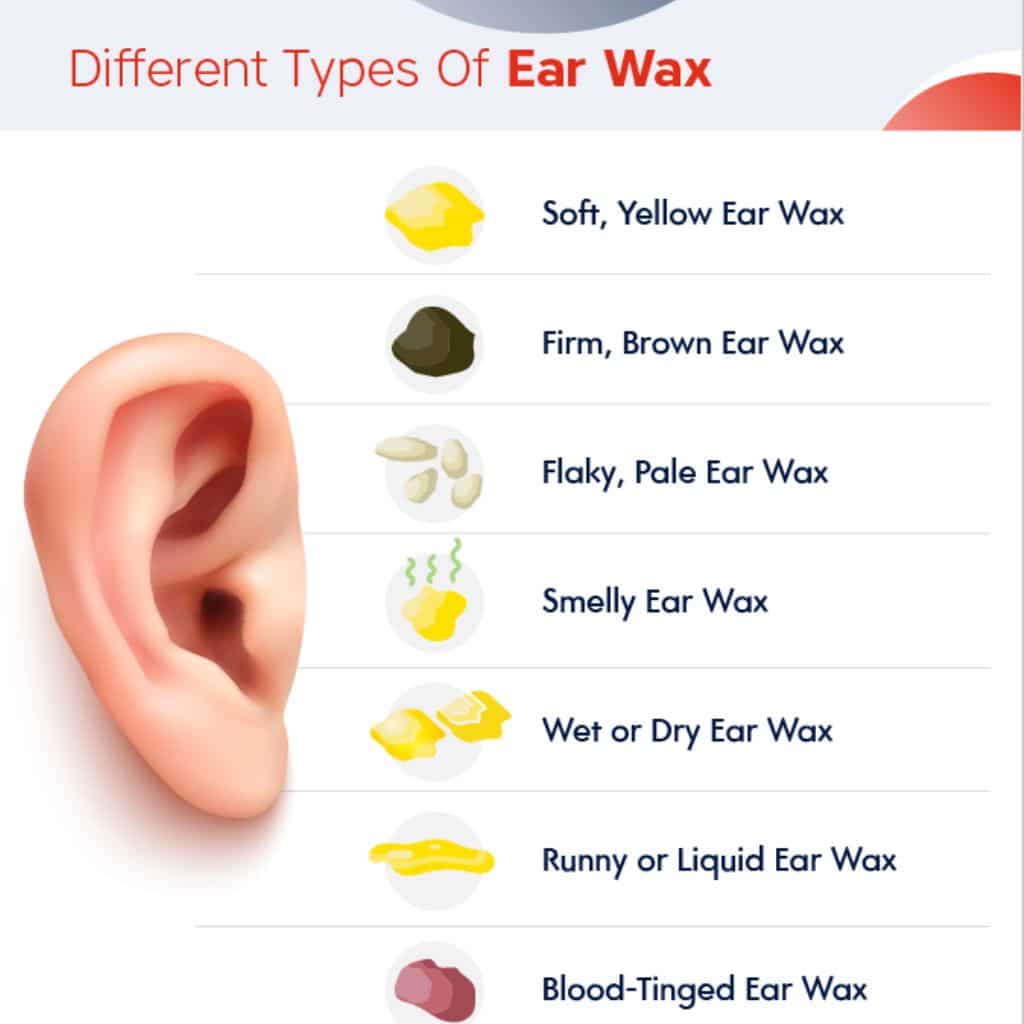Did you know that there are different types of ear wax?
Have you noticed changes in the way your ear wax looks and feels? Are you concerned about the colour and texture of your ear wax?
Ear wax comes in many different types.
Your genetic background dictates what type of ear wax you have. Wet wax (honey coloured, sticky wax) is more common amongst Caucasians and Africans, while dry wax (white or grey and flaky) is more common in those of Asian descent.
Most of the types of ear wax that you will notice are completely normal and nothing to be concerned about. Others may be a sign of impaction, infection, or injury.

Different Types Of Ear Wax
Soft, Yellow Ear Wax
This is the most common and the healthiest type of ear wax that you are likely to notice in your ears. When your wax is yellow in colour and has a soft consistency, it normally means this wax is new. This is a sign of healthy ear wax production, as your wax isn’t hardening too much before it falls out.
Firm, Brown Ear Wax
If your ear wax is a darker yellow or a brownish colour, this is a sign of older ear wax that may have hardened. You will notice that the texture is not as soft as the fresher, more healthy wax. If you notice this coloured wax and are suffering from wax related symptoms, it may be a sign of an impaction, and you should have your ears checked by a professional.
Flaky, Pale Ear Wax
Ear wax that is flaky and pale in colour is an indication of a healthy self-cleaning mechanism taking place within your ear. Earwax tends to become flaky and pale as it heads to the outer third of the ear canal and combines with shedding skin. This type of wax is not a cause for concern.
Smelly Ear Wax
If you have ear wax that comes with an odour, it could be cause for concern. It may indicate that you have some kind of infection. Some types of bacteria emit a foul smell, making your ear wax smell equally as bad. If an ear infection gets too serious, it can cause middle ear damage. So always seek medical attention.
Wet or Dry Ear Wax
There are two primary types of earwax—wet and dry:
- Wet cerumen is more common in Caucasians and Africans
- Dry cerumen is more common among Native Americans, Pacific Islanders and those of Asian background.
Runny or Liquid Ear Wax
Runny or liquid ear wax is different to wet ear wax, and the two should not be confused. Runny ear wax can sometimes occur after diving or swimming, when the wax mixes with water. However, there could be a more serious issue at play, This may be due to a middle ear infection or ruptured ear drum, through to damage in your ear canal or even a skull fracture. Seek medical advice if you are concerned.
Blood-Tinged Ear Wax
If you notice blood in your ear wax, this is normally an indication of some injury to the ear. This could be a scratched ear canal, a cut inside the outer ear, or more serious ear trauma. Always seek medical attention if you notice blood in your ears.
When To Seek Medical Advice
Sometimes you may notice cloudy earwax that has a runny texture. This fluid may or may not have an offensive smell. You may also have associated symptoms of pain, itching, or an uncomfortable feeling within the ear. If you are experiencing these symptoms, the runny, cloudy substance is probably not wax but rather a fluid related to a bacterial or fungal infection, which may need to be treated with prescription ear drops. Keep the ear dry and seek medical advice.
Sometimes, foreign bodies become stuck inside of the ear canal. If you notice anything in your ear wax which is unusual, it is a good idea to see a doctor as any debris inside of the ear may require manual removal by a professional. Remember, attempting to remove foreign objects from your ears using your fingers, cotton tips, or other methods can be dangerous and cause serious damage.
More Information
If you have questions or concerns, feel free to contact the friendly Earworx team. We’re more than happy to help answer your questions and to assist you in relieving your ears of uncomfortable, wax-related symptoms.
